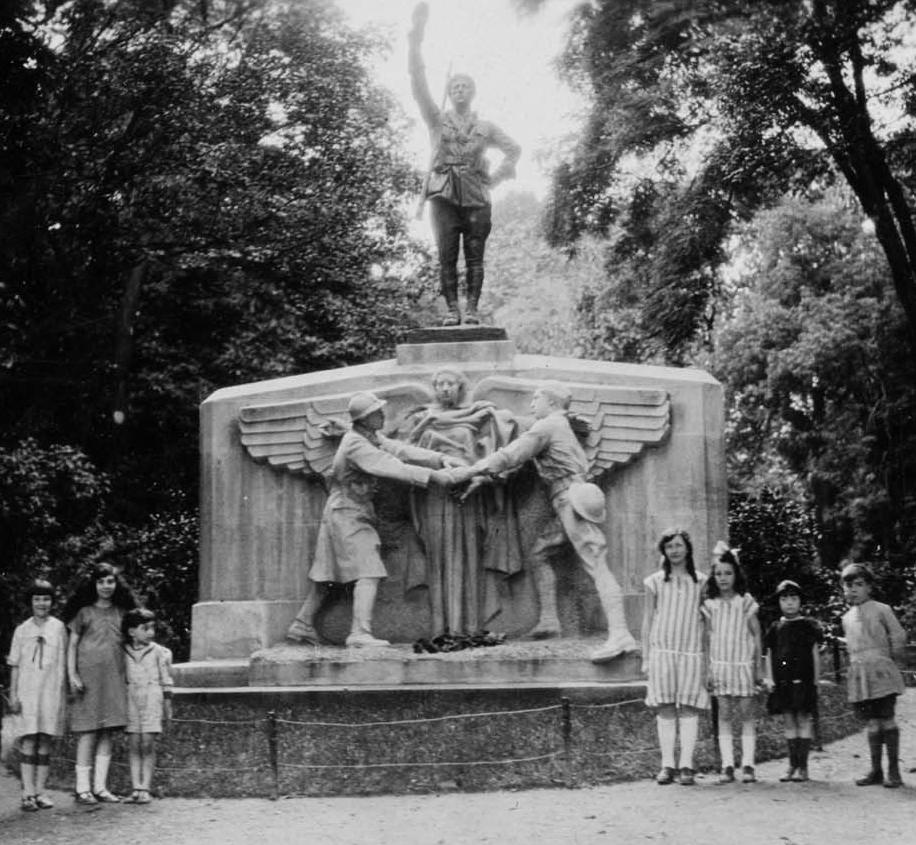
World War I Aftermath: War Memorials

Figure 1.--This snapshot taken about 1921 was from an album compiled by a member of a group of Americans on an European tour. The photo shows some French children posing in front of a aewly built war memorial. The location in France is not identified. A caption from a society page clipping reads, " To tour Europe by Motor, Miss Avis Brook, daughter of Mr. and Mrs. H. D. Book, 965 Highland Avenue, who recently sailed on the 'S.S. Olympic' -- Winn Studio '. We see a French Poilu reaching out to an ally, although we ar not sure if he is British or American. The soldier over them may honor the fallen.
|
|
World War I ocured after about a century of relative peace and enormous material in Europe. This made the terriblke killing nd dstruction all the more terrible. World War I or the Great war as it was called at the time shattered European society and an entire generaton. It was apparent even before the War had ended thst Europe would be chnged for ever. People in the victotious Allied countries began referring to the war as “The War to end All Wars”. After 4 years of bloody warfare, loss, amd privations, there was a unversal desire in all the beligerant contries to honor the fallen and those who made such sacrifices. Few families were unaffected by the War in someway and many had a family member killed or seriously wonded. There was also enormous property damage Citieswere badly damages in the fishing or combaing. Whole village was simply erased. Communities, churcges, schools, and veterans associations wanted to honor the fallen. The question was just how to do that. As a result war meorials began appearing in cities and towns during the 1920s. There were both public and private memorials. They vatied greatly in style and construction. Many included the mames of the fallen from the cities or towns, schools, churches, factories, sports clubs, railway stations, and other locations. These were commonly memorial rolls of honor. Some of the city public momunments were grandiose. I found espcially moving the churches across Britain that maintain a book of the fallen and change the page every day. Church windows were designed and dedicated to military units or individuals. Memorial buildings in schools and cities were dedicated as living memorials. Garadually memorials arose on some of the major battlefields of the War, usually round the millitary cenetaries. Such was the carnage. Large numbers of the fallen could not be identified. Veterans grops placed memorials on the battlefields remember their units, units such as divisions, regiments and battalions. The battlefield monuments are mostly in Allied countries because the War began when Germany invaded Belgium and France and the major battles were fought there. It addition to brick and mortar, other ideas surfaced. We see memorial plaques and commemorative peace medals. Especially important was medical and convalesent care for veterans. Here both public and state funds were involved. One of the most important traditions is the Flanders Fields Memorial Poppy. The British still wear poppies as November 11 approches each year. A Canadian reader tells us that this is a also a tradition there. We think this is also trur in Australia and New Zelnd. It is a touching tradition, but trafically the message given to the children is the sacrifice the soldiers made for Britain and the Dominions, rarely touching on the great contribution to the world in both World War I and even more so in World War II. As these memorials were going up, people in the victorious Allied nations began to question the war effort and without the least foundation, blaming the War on greedy industrialists. Pacifist sentiment grew. One result was the abadonment of democratic Czechoslovakia by Britin and France (1938) and the quick collapse of France wgen the Germn struck a second time (1940). In the British Dominions, people began to think the sacrifices made were to defend Britain and not their own countries. World War II brought about a rethinking of this mindset, especially as the Japanese Imperial Army and Navy reached the borders of Australia (1942).
CIH - WW I

Navigate the CIH World War I Section:
[Return to Main World War I aftermzth page]
[Return to Main French World War I page]
[Return to Main World War I page]
[Alliances]
[Animals]
[Armistace]
[Biographies]
[Causes]
[Campaigns]
[Casualties]
[Children]
[Countries]
[Declaration of war]
[Deciding factors]
-------[Diplomacy]
[Economics]
-------[Geo-political crisis]
[Home front]
[Intelligence]
[Military forces]
[Neutrality]
[Pacifism]
[People]
[Peace treaties]
[Propaganda]
[POWs]
[Russian Revolution]
[Signals and intelligence]
[Terrorism]
[Trench warfare]
------[Technology]
------[Weaponry]
[Bibliographies]
[Contributions]
[FAQs]
[Images]
[Links]
[Registration]
[Tools]
[Return to Main World War I page]
[Return to Main war essay page]
Created: 5:51 AM 8/20/2015
Last updated: 4:03 PM 8/20/2015



